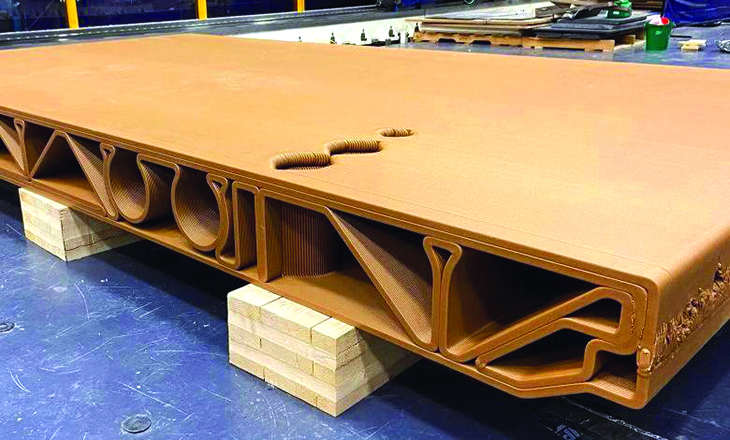‘Green’, 3D-printed panel floors it!

A collaborative team from the University of Maine and the Department of Energy’s Oak Ridge National Laboratory (ORNL) in the US has achieved a significant breakthrough in sustainable construction. They have created a recyclable, single-piece floor panel that is strong enough to potentially replace traditional materials like steel.
This innovative project is part of the Sustainable Materials and Manufacturing Alliance for Renewable Technologies (SM2ART) initiative. Notably, the team previously developed BioHome3D, the first home in the US made entirely from biologically based materials.
The newly designed SM2ART N-floor cassette panel aims to transform how apartment and condominium buildings are constructed by replacing conventional steel-and-concrete surface assemblies. This technology opens the door to creating environment-friendly, strong, biologically based components, which could enhance the sustainability of multistorey buildings.
Key advances
Katie Copenhaver, a researcher at ORNL, emphasised the advancement made with this project. “Our first attempt to create a robust building floor panel using green resources significantly boosts the potential for integrating organic materials in modular residential buildings,” she stated.
“Using bio-based, large-scale 3D printing, we simplified the assembly from 31 parts and three materials to a single-material floor panel that is both ecologically sound and as strong as traditional steel.”
The strength of the SM2ART floor cassette comes from its unique blend of polylactic acid (PLA) and wood flour, derived from corn residue and lumber processing waste.
Scott Tomlinson, a structural engineer at the University of Maine’s Advanced Structures and Composites Center, highlighted the advantages of this blend. “It’s an excellent material for producing recyclable, large-format additively manufactured components,” he noted.
“This single-piece floor assembly is stiffer and offers a superior walking experience compared to traditional steel-concrete setups.”
Researchers utilised a large-scale 3D printer to construct the floor panel by precisely layering the PLA and wood flour mixture. This method allows the printer to operate autonomously and continuously, producing the N-floor cassette in about 30 hours, yielding a labour savings of roughly 33% compared to manual assembly of a steel floor.
Traditional steel frame construction incurs significant costs due to the manual labour involved in cutting channels for electrical and plumbing systems. “3D printing can eliminate this by integrating cutouts directly into the floor cassette design,” Copenhaver explained. “Human labour is only required for installing sound-proofing and the chosen floor covering.”
Fully recyclable
Another significant benefit of the SM2ART N-floor cassette is its full recyclability. Unlike typical construction materials that end up in landfills, the PLA used in these panels can be repurposed into new products after a building’s demolition, promoting a circular economy.
The concept for this project was proposed by SHoP Architects, a design firm based in New York City. Copenhaver remarked: “They challenged us to mass-produce floor panels using greener materials and additive manufacturing. Experimentation and innovation are core to ORNL’s mission, and we successfully optimised the production process to ensure quality and consistency.”
While the N-floor project is still in its early stages, future research will explore enhancements such as flame retardants, sustainable insulation options, and improved production techniques.
Tomlinson noted, “Our next steps focus on increasing efficiency and cost-effectiveness while adding functionality. This technology has great potential for the future of sustainable building practices.”
Current research on the SM2ART N-floor cassette is being conducted at the Manufacturing Demonstration Facility at ORNL, with design and printing activities happening at the University of Maine’s Advanced Structures and Composites Center.
Comments

- ‘Red gazelle’ makes window installation easy
- Felder’s solutions for window and door production
- Versatile sliding-folding systems from Hafele
- Door line automation from Woodtech Consultants
- Accutec solutions for uPVC windows
- Jowat’s VOC-free primer for window profile wrapping
- Flexible solutions for doors, windows from SCM
- Tostem introduces Giesta steel doors; calls for dealers
- Folder system by Salice optimises cabinet space
- Turakhia has top-quality veneers for doors
- Mirka has solutions for difficult sanding of doors
- When Lamello’s Cabineo became a game changer
- Digital lacquer embossing for flooring from Hymmen
- Weber sanders help achieve luxury surfaces
- Rehau has designs on growing edge band market
- Samet ties up with Greenply to tap Indian hardware market
- IMA Schelling sets up base in India
- Hettich earns BIS nod for hinges, runners
- Biesse India now a Multi-Material Expert
- The importance of selecting the correct tools
- Indian cabinet maker shines at Lyon WorldSkills
- ‘Collaboration holds the key to success’
- Fibreboard recycling becomes a reality
- MumbaiWood now a recognised destination
- Knock on wood: A bouquet of training courses!
- Ligna 2025: ‘Thinking in circles’
- CIFF-Shanghai focuses on furniture design
- Felder hosts in-house show, Technology Days
- Interzum Forum Italy makes impressive debut
- Koelnmesse ties up for 3-in-1 Jakarta fair
- WOFX: a global hub for innovation and growth
- Events Calendar: industry fairs you must visit
- 3D is printing sustainable housing solutions
- Hard or soft? Researchers discover new wood type
- Master, apprentices take AHEC’s cherry challenge
- ‘Zero-to-launch’ modularity transforming hospitality
- ICA’s Urban Matter is about satin-finish metal effect
- MTC’s ‘Woven timbers’ create waves
- Impact of material in interior design
- Underestimated danger: Sharp edges
- Playing safe on clothing storage units
- ‘Green’, 3D-printed panel floors it!
- Adhesive-free joining of wood, metal
- Energy-efficient manufacturing of fibre-based products
- Rice bran wax: a sustainable alternative
- Dual-side hand sanding block has unique features
- Bio-based products for sustainable development
- ‘Wood Vaulting’ may enhance CO2 sequestration
- Protecting forests through advanced AI
- Forest certification benefits wildlife too!
- Elizure, the Rolls Royce of laminates!
- Rehau unveils new Rauvisio Riviera collection
- Hawa Concepta III: upgrade to seamless functional doors
- Hafele’s RE-Twist locks in on security
- Optimus machines feature tomorrow’s technology today
- Merino unveils cutting-edge offerings
- Ornare launches new premium laminates
- New nesting models from SCM
- Advanced moulder, membrane press from Woodtech
- Greenlam Laminates unveils exclusive display centre in Pune
- EUDR implementation dates may be deferred
- Herman Miller introduces bamboo upholstery
- Altendorf named ‘Brand of the Century’
- Catas to verify its test reports
- Combilift wins two prestigious awards
- Holz-Her management transition
- Replica of the Oval Office opens
- Ozone Blu sets up experience centre
- SCM opens new subsidiary in Slovenia
- VDMA faces business stagnation
- RentoMojo reports strong growth in FY24
- Century Plyboards on expansion mode
- Subhra named DG of FSC
- Meta to assist Skill India Mission
- Sugatsune opens Bengaluru experience centre
- Dieffenbacher acquires Pagnoni
- Pepperfry partners with Infra.Market
- Hafele opens light store in Chandigarh









































